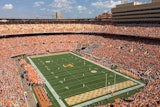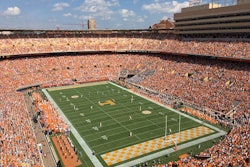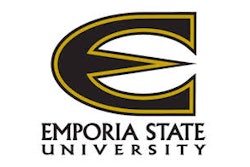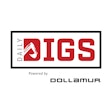Fitting in physical activity is as much about finding a place as finding time. Larger cities especially are hardpressed to provide more parks and recreational areas in already cramped quarters.
 REDISCOVERING RECESS Converted school playgrounds provide a place not just for kids but also adults to engage in activity. (Photos Courtesy of People for Parks)
REDISCOVERING RECESS Converted school playgrounds provide a place not just for kids but also adults to engage in activity. (Photos Courtesy of People for Parks)Fitting in physical activity is as much about finding a place as finding time. Larger cities especially are hardpressed to provide more parks and recreational areas in already cramped quarters.
Unable to find open space amid the crowded streets of Los Angeles to build a park, the nonprofit organization People for Parks instead focused on maximizing the play space the city already had, converting two school playgrounds into community parks. "Los Angeles ranks last out of the largest cities in the country for children to be able to walk to a park," says People for Parks president and co-founder Jack Foley. "The largest landowner in the county is the school district. It just makes a lot of sense from a policy standpoint to put these schools into use."
The plan is in line with a recommendation in "Lots to Lose," a 90-page report released in June by the Bipartisan Policy Center addressing the nation's obesity epidemic. According to the report, "Local governments should leverage existing resources and infrastructure assets to expand opportunities for physical activity." While schools may struggle to find time to provide physical activity during school hours, they provide an ideal resource to serve the needs not just of students but entire communities after school hours.
Since opening community-school parks at Trinity and Vine Street elementary schools earlier this year, Foley says the community is already seeing a difference. "At Trinity, the principal started a running club and has about 50 kids. In six months, those 50 kids have lost significant weight."
It took five years for People for Parks to open its first community-school parks. In San Antonio, Texas, the idea had been floating around for more than 20 years. "There's an elementary school within walking distance of every home in our community, and probably within 90 percent of the homes in America," says George Block, chairman of the nonprofit organization San Antonio Sports, which first suggested the idea to the city back in the 1990s. "It went nowhere. We kept bringing it up. Then about three years ago, one of our city council members started getting interested in this. He came to us and said, 'Let's get something done.' "
The city council voted in April to adopt SPARK, a model school park program created by the City of Houston in the '80s. The goal of the program, which has opened more than 200 school parks in Houston and has been licensed by other communities across the country, is to bring municipal, nonprofit and private organizations together to convert school playgrounds into community parks. "The main benefit for us is that we get to piggyback on Houston's 30-year grant history," says Block.
As simple as it would seem to take an area already dedicated to physical activity and make it more available, the reality is that there are myriad considerations that must be addressed - getting the school district, city and other relevant entities on board and working out a shared-use agreement, dealing with liability issues, finding funding to make improvements. In San Antonio, the school district provided the first and biggest obstacle. "It was control and access, schools not wanting other people on the property after hours," Block says.
With limited budgets of their own, school districts are wary of anything that would add to their burdens. "Vandalism was probably the big concern, but it actually ends up the opposite," says Block. "Vandals can hop a school fence and do whatever they want to do, but the more people that are there using the school, the more eyes are on it. The more people that care about it, the less vandalism."
Schools seeking to keep their resources private often cite concerns about additional maintenance or increased wear and tear, but at least in San Antonio, Block expects the consequences will be just the opposite. "The schools' P.E. fields are so worn that all we're going to do is improve them. They're just dustbowls. We're basically taking a P.E. play area and upgrading it. The schools will end up with a lot more recreational and P.E. space."
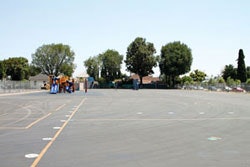 ASPHALT ASSETS Countless playgrounds owned by the Los Angeles Unified School District have the potential to become community resources. (Photos Courtesy of People for Parks)
ASPHALT ASSETS Countless playgrounds owned by the Los Angeles Unified School District have the potential to become community resources. (Photos Courtesy of People for Parks)Once the SPARK program was approved in San Antonio, representatives from the city, county and various other organizations were brought together to form a plan of action for the first project at Sky Harbour Elementary School, set to open this fall. "Whether the school has enough space to do something meaningful is the first issue," says Block. Part of converting a playground into a community park requires the addition of other features that offer wider appeal, and inner-city San Antonio is more densely packed, leaving the schools with less free space to add and improve than those farther out.
Sky Harbour renovations also include a playground, a soccer field, basketball courts and a fitness trail. "The biggest thing communities want is walking paths," Block says. "We're trying to be really responsive to the community but also come up with enough of a template that we can make sure it's in the budget. Maybe get a bunch of bids on walking paths, and then get a company to go out and do them; we get a much better price doing 10 instead of one. It makes it faster, too, and more replicable."
In Los Angeles, People for Parks was faced with the challenge of not just making school grounds functional but inviting. "You had asphalt, an older school that didn't have a lot of trees or lawn," says Foley. "Cyclone fencing, grates over the windows - the schools were very forbidding. They almost looked like mini-prisons."
The conversion of the Trinity and Vine Street parks started with tearing up the asphalt and concrete. "We created running tracks and playground equipment, soccer fields, community gardens," says Foley. "Immediately after opening those facilities, we noticed women in the community using the tracks. There's perimeter fencing around the school, a gate opens to let kids in - it's a high-crime neighborhood, but women can feel comfortable walking within the school grounds on the school track."
Community parks projects aren't cheap. Foley estimates the cost of converting a Los Angeles playground at anywhere from $500,000 to $1.3 million. Then there's the cost of keeping the parks maintained. Grants are funding People for Parks' next five projects, but after that, Foley hopes that his group can scale back their involvement. "Once you get this going and develop the structure, then you're in a position to sit down and bring all the pieces together," he says. "The next step is to institutionalize this."
Once the pilot park at Sky Harbour is complete, Block says the program will aim to open one new park in every city council district and county precinct, a total of 14, per year. "We think once people see this succeeding, they'll say, 'Let's do that in our neighborhood, too,' " he says. "Like anything else, funding is really about priorities. If this becomes a priority for a community, there will be funding available. Nobody's got to fund the whole thing - the shortage of parks and the problem of obesity is so big that no one group can or should be expected to say grace over it. But if everybody comes together - the youth leagues, schools, cities, counties, nonprofits - if everybody comes in a little bit, we can get a lot done."














